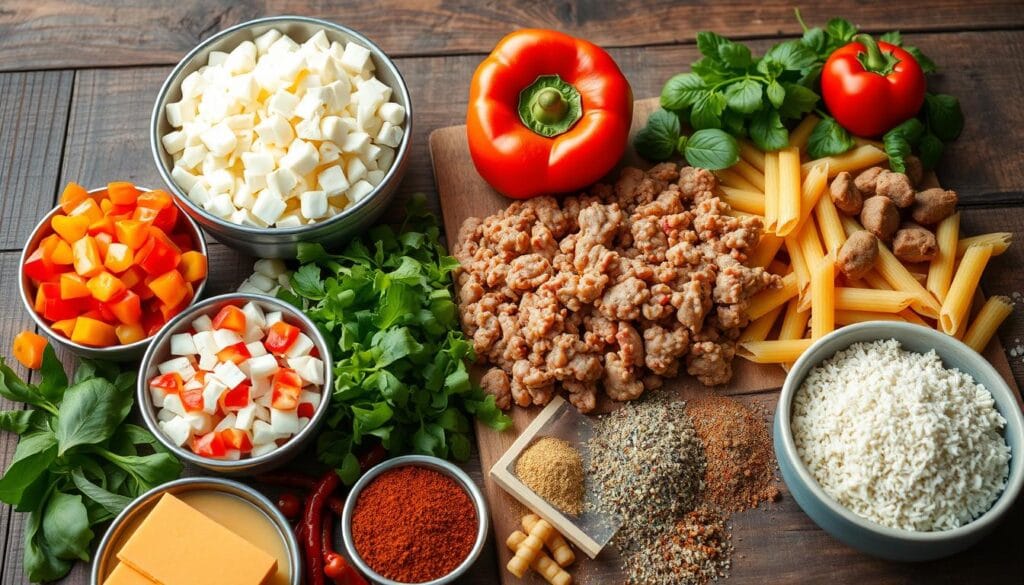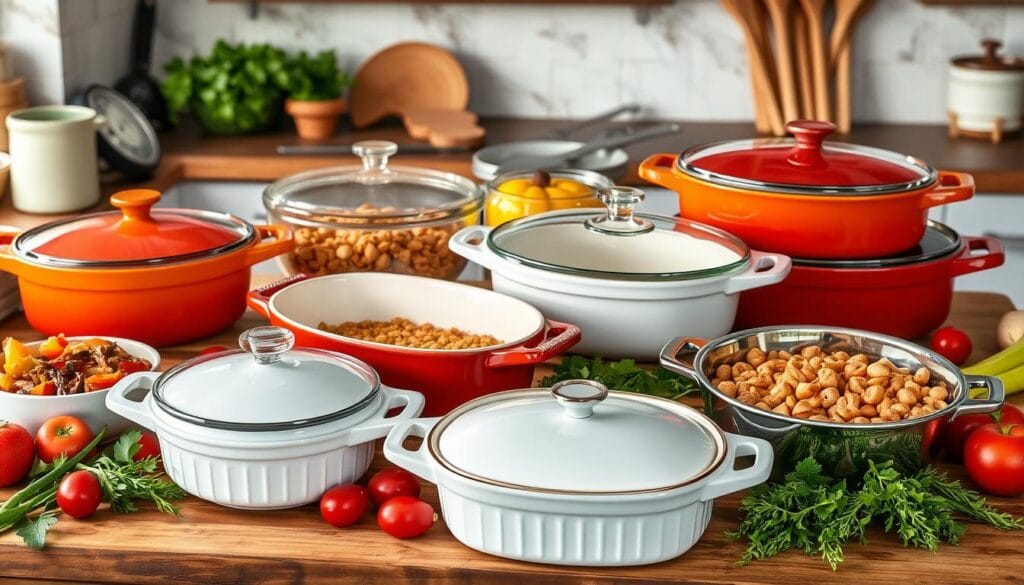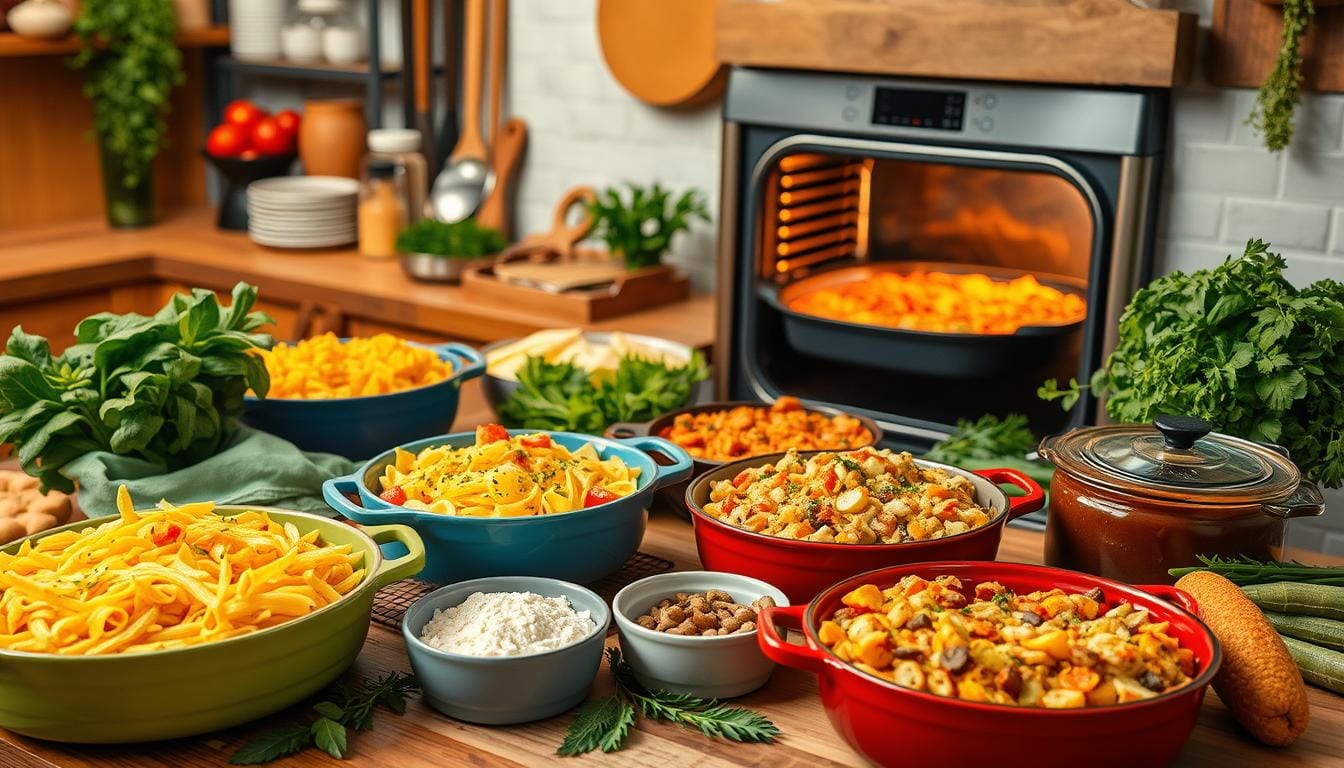What makes a casserole unforgettable? How can you impress your family and friends with easy casserole dishes? Creating the perfect casserole is an art. It needs basic knowledge and simple steps.
With the right ingredients and creativity, you can make a masterpiece. This dish will become a staple in your home, loved by all.
Exploring casserole recipe ideas reveals the key to success. It’s understanding the basics, like essential ingredients and equipment. From chicken casseroles to vegetarian delights, the options are vast. Our guide will help you create delicious, easy casserole dishes that will be favorites in your home.
Whether you’re new to cooking or experienced, making a good casserole is about experimenting and having fun. Let’s start this culinary journey. We’ll explore casserole recipe ideas, easy casserole dishes, and the secrets to making the perfect casserole. Everyone will want more.
Table of Contents
Understanding the Basics of Making the Perfect Casserole
To make a tasty casserole, knowing the basics is key. A casserole has layers of ingredients like protein, veggies, and starch. It’s topped with a crunchy crust or savory sauce. Using top-notch ingredients is vital for a great taste.
Having the right tools, like a big baking dish, is important. This knowledge helps you make many tasty casseroles. You can adjust them to fit different tastes and diets, perfect for family or parties.

When making a casserole, use 1 1/2 to 2 cups of protein, 1-1 1/2 cups of veggies, and 1 1/2 to 2 cups of starch. Add 1/2 cup of creamy ingredient and 3/4 cup of grated cheese for extra flavor. Following these tips and using the best ingredients will make your casserole a hit.
What Defines a Casserole
A casserole is a flexible dish made with various ingredients. The secret to a great casserole is using fresh ingredients and basic cooking skills. By knowing what makes a casserole and using tips, you can make a meal that’s perfect for any event.
Essential Equipment Needed
Having the right tools is key for a great casserole. You’ll need a big baking dish and utensils. Good equipment ensures your casserole is perfect and easy to serve.
Basic Cooking Principles
Knowing basic cooking principles is essential for a delicious casserole. This includes the right temperature, cooking time, and technique. By following these and using popular casserole ideas, you’ll impress everyone with your dish.
Selecting Your Casserole Dish Size and Material
Choosing the right dish size and material is key for simple casserole recipes. A large, deep dish is perfect for layered casseroles. On the other hand, a smaller dish is better for simpler recipes. The dish’s material, like glass or ceramic, can also impact cooking time and presentation.
For casseroles that need to be evenly heated, pick a dish that does this well. Ceramic and glass dishes are favorites because they keep heat and are easy to clean. Stainless steel and cast iron dishes are also good, as they’re durable and retain heat well. Think about the size and material that fits your recipe best.
Here are some important things to think about when picking a casserole dish:
- Dish size: 9×13 inch dishes are great for family meals, while smaller ones are better for simpler dishes.
- Material: Glass, ceramic, stainless steel, and cast iron are popular, each with its own benefits.
- Heat retention: Ceramic and glass dishes keep heat well, while stainless steel and cast iron heat up fast.
- Easy cleanup: Non-stick surfaces and dishes with rounded corners are easy to clean.

Choosing the right casserole dish can make your dish both delicious and beautiful. Whether it’s a simple recipe or a complex flavorful casserole, the right dish matters a lot.
| Dish Material | Heat Retention | Easy Cleanup |
|---|---|---|
| Glass | Excellent | Yes |
| Ceramic | Excellent | Yes |
| Stainless Steel | Good | No |
| Cast Iron | Excellent | No |
Essential Ingredients for a Flavorful Base
The base of a casserole is key to its taste. Choose proteins like chicken, beef, or tofu, and pick veggies like broccoli, carrots, or bell peppers. Healthy casseroles often mix veggies for texture and taste.
For easy casseroles, use pre-cooked chicken or frozen veggies. This saves time. Fresh, seasonal, and quality ingredients make a base that’s tasty and healthy.
Choosing the Right Proteins
Proteins are vital for a casserole’s structure and flavor. Options include chicken, beef, pork, and tofu. Think about the flavor and texture you want. Chicken and beef are common, while tofu is great for vegetarians.
Selecting Complementary Vegetables
Vegetables add texture, flavor, and nutrients. Broccoli, carrots, bell peppers, and onions are popular. Choose veggies that cook well and are tender. Pre-cooking veggies helps with moisture and texture.

Understanding Binding Agents
Binding agents like cheese, eggs, or cream keep ingredients together. They add moisture and flavor. The right mix can greatly improve your casserole’s texture and taste.
Mastering the Layer Technique
Layering ingredients is key to a great casserole. It ensures each part cooks well and flavors blend. Start by softening onions before adding them to the mix. This step boosts flavor and texture.
Some simple casserole recipes have a set layer order. Begin with a base, then add protein and veggies, and top with a crunchy layer. This order helps flavors mix well. Feel free to try new ingredients and layering methods for unique dishes.
Here are tips for layering:
* Begin with a solid base, like cooked veggies or grains.
* Next, add a protein layer, like meat or beans.
* Follow with a sauce or cheese layer to hold everything together.
* Finish with crunchy toppings, like breadcrumbs or nuts.
Follow these tips and explore casserole recipe ideas to make tasty dishes. Whether you’re after simple casserole recipes or complex ones, mastering layering is vital. With practice, you’ll impress everyone with your casserole skills.
| Ingredient | Quantity |
|---|---|
| Ground beef or turkey | 1 lb |
| Diced tomatoes | 1 can |
| Corn kernels | 1 can |
| Shredded cheddar cheese | 1 cup |
Creating the Perfect Sauce Foundation
To take your casserole to the next level, focus on a rich, flavorful sauce. This is your chance to get creative with homemade casserole tips. Try out different ingredients to find the perfect mix. The sauce can also add a unique twist to a classic dish, making it stand out.
Creating a great sauce foundation is easy with ingredients like cream, tomatoes, and spices. For a creamy sauce, mix sour cream, milk, and shredded cheese. This flavorful casserole combination is sure to be a hit. Or, you can go for a tomato-based sauce, using crushed tomatoes and tomato sauce as the base.
- Pesto sauce for a creamy and herby flavor
- Salsa for a spicy kick
- Marinara sauce for a tangy and savory flavor
By trying out different sauce combinations, you can make a casserole that’s both unique and delicious. Remember to balance your flavors. And don’t hesitate to add your own homemade casserole tips to make it extra special.
Selecting Proper Seasonings and Herbs
Choosing the right seasonings and herbs is key to making great casseroles. For easy dishes, fresh herbs like thyme, rosemary, or parsley add a fresh taste. Spices like cumin, paprika, or chili powder bring depth and warmth to your casseroles.
Proper storage of herbs is important. Store woody herbs like rosemary and thyme in a damp paper towel in the fridge. Basil and similar herbs can last up to 10 days in a mason jar with water. Add delicate herbs like basil, mint, and cilantro towards the end of cooking to keep their flavor.
Here are some tips for selecting and using the right seasonings and herbs:
- Choose fresh herbs that look vibrant and crisp with no signs of yellowing, browning, or wilting.
- Use woodier herbs like thyme and rosemary in dishes where they will be cooked for a longer period, and chop them finely for optimal flavor release.
- Add delicate herbs like basil and mint towards the end of cooking to preserve their flavor and aroma.
By following these tips and using the right seasonings and herbs, you can create delicious and healthy casseroles. Whether it’s a macaroni and cheese casserole or a shrimp and grits casserole, the right herbs and spices make a big difference in taste and aroma.
Top Tips for Texture and Consistency
Getting the right texture and consistency in a casserole is key. To avoid dryness or sogginess, watch the moisture level. Simple recipes balance ingredients for the perfect texture.
Adding a crunchy topping, like breadcrumbs or nuts, can enhance your casserole. It adds a nice crunch against the soft, creamy inside. Think about the moisture of each ingredient to affect the dish’s texture.
Here are some tips for the right texture and consistency:
- Use the right liquid to solid ratio.
- Avoid overcooking to prevent dryness.
- Add moisture-retaining ingredients like sour cream or yogurt.
By following these tips and trying different recipes, you can make a delicious and attractive casserole. Keep your recipes balanced and moist. Don’t hesitate to add your own creative touches.
With practice and patience, you’ll become a pro at making impressive casseroles. So, why not start today and explore some new recipes?
| Ingredient | Moisture Content | Texture |
|---|---|---|
| Veggies | High | Soft |
| Meat | Medium | Tender |
| Grains | Low | Crispy |
Temperature and Timing Guidelines
When baking a casserole, knowing the right temperature and timing is key. The size and type of casserole, along with the ingredients, play a big role. For instance, a casserole with raw veggies will take longer to bake than one with pre-cooked ingredients. Following these guidelines ensures your casserole is cooked evenly and tastes great.
Start by preheating your oven to 350-400°F. The baking time varies by casserole size, but aim for 30-45 minutes. This is when the casserole is hot and the top is golden. For dishes like lasagna or chicken enchiladas, you might need to adjust the time and temperature. Always check the casserole to avoid overcooking and let it rest before serving.
Here are some general guidelines to keep in mind:
- Preheat the oven to 400°F for 15-20 minutes before baking.
- Bake the casserole covered for 30-40 minutes, then uncover for 10-15 minutes.
- Let the casserole rest for 5-10 minutes before serving.
By following these tips and using your judgment, you can make a delicious homemade casserole. Whether it’s a classic dish or something new, understanding temperature and timing is the secret to success. This way, you can enjoy tasty casserole combinations and variations.
The most important thing is to use your best judgment. Adjust the temperature and timing based on your casserole and ingredients. With practice and patience, you’ll become a pro at making homemade casseroles. You’ll enjoy the benefits of homemade casserole tips and popular variations.
| Casserole Type | Temperature | Baking Time |
|---|---|---|
| Lasagna | 375°F | 30-40 minutes |
| Chicken Enchiladas | 400°F | 25-35 minutes |
| Vegetable Casserole | 350°F | 40-50 minutes |
Make-Ahead and Storage Strategies
When making easy casserole dishes, it’s key to make ahead and store them right. You can prep healthy options like lasagna or chicken enchiladas a day before. This lets the flavors mix well. Always cool the dish to room temperature before putting it in the fridge or freezer.
Some casseroles can stay frozen for 3 months. Others can chill in the fridge for 48 hours before baking. Recipes like breakfast bakes need 8 to 24 hours to get better flavors. To warm them up, use the oven or microwave.
Here are some tips for making ahead and storing casseroles:
- Prepare casseroles up to 24 hours in advance to allow flavors to meld together.
- Cool the dish to room temperature before refrigerating or freezing.
- Freeze casseroles for up to 3 months or assemble and chill in the fridge for up to 48 hours before baking.
By using these strategies, you can enjoy your favorite casseroles anytime. This way, you keep the best ingredients and flavors.
| Casserole Type | Make-Ahead Time | Storage Method |
|---|---|---|
| Lasagna | Up to 24 hours | Refrigerate or freeze |
| Chicken Enchiladas | Up to 24 hours | Refrigerate or freeze |
| Breakfast Bake | 8 to 24 hours | Refrigerate |
Popular Casserole Variations for Every Season
There are countless ways to make a great casserole. You can pick from many recipes to match your taste and diet. Whether you love chicken, beef, or veggies, there’s a casserole for every event.
For a tasty and quick meal, try these simple casserole recipes. You can use fresh ingredients to make a dish that’s both tasty and healthy. You can make chicken, beef, or veggie casseroles with easy ingredients and little prep.
Here are some popular casserole variations:
- Chicken and rice casserole
- Beef and broccoli casserole
- Vegetarian quinoa casserole
These are just a few ideas. With a bit of creativity, you can make your own unique casserole dishes. Start with simple recipes and experiment with different ingredients.
| Casserole Variation | Prep Time | Cook Time | Servings |
|---|---|---|---|
| Chicken and Rice | 20 minutes | 30 minutes | 6-8 |
| Beef and Broccoli | 25 minutes | 35 minutes | 6-8 |
| Vegetarian Quinoa | 15 minutes | 25 minutes | 4-6 |
Troubleshooting Common Casserole Problems
When making a homemade casserole, you might face issues like a watery texture or uneven cooking. Understanding the causes and using the right tips can help. For example, sautéing onions before adding them can prevent a watery texture, making the casserole more flavorful.
A runny casserole can happen if frozen green beans aren’t properly defrosted and drained. To fix this, make a slurry of flour or cornstarch with liquid like broth or water. This helps thicken the dish. This trick works for many casserole types, making your meal delicious and satisfying.
Some common problems and their solutions include:
- Watery texture: defrost and drain frozen vegetables, sauté onions before adding them to the casserole
- Uneven cooking: ensure the casserole is cooked at the right temperature, use a thermometer to check the internal temperature
- Overcooked dishes: check the casserole regularly while it’s cooking, avoid overcooking the ingredients
By following these tips and understanding common problems, you can make a tasty and beautiful casserole. It will show off a variety of flavors and popular casserole variations.
| Problem | Solution |
|---|---|
| Watery texture | Defrost and drain frozen vegetables, sauté onions before adding them to the casserole |
| Uneven cooking | Ensure the casserole is cooked at the right temperature, use a thermometer to check the internal temperature |
| Overcooked dishes | Check the casserole regularly while it’s cooking, avoid overcooking the ingredients |
Conclusion: Mastering Your Casserole Creation
Creating tasty casseroles is an art that needs practice and trying new things. By using the tips from this article, you can make a good casserole that will wow your loved ones. Don’t be afraid to get creative and try out casserole recipe ideas to find your favorite.
Whether you’re an experienced cook or new to casseroles, the main thing is to focus on flavor and texture. Try out different easy casserole dishes, from classic favorites to seasonal specials. With some effort and lots of love, you’ll soon become a pro at making casseroles.
FAQ
What is the secret to a good casserole?
The secret to a good casserole lies in balancing flavors, textures, and moisture. Start with a flavorful base, such as meat, vegetables, or grains. Ensure that your casserole has enough moisture from broth, sauce, or cream to prevent it from being dry. A crispy topping made from cheese, breadcrumbs, or crispy onions adds both flavor and texture.
What are the 5 components of a casserole?
The five main components of a casserole typically include:
Protein (such as chicken, beef, or beans)
Vegetables (like broccoli, peas, or carrots)
Carbohydrates (such as pasta, rice, or potatoes)
Binder (such as a cream-based soup, cheese, or egg)
Topping (like breadcrumbs, cheese, or crushed crackers)
What are the basics of a casserole?
The basics of a casserole include a combination of protein, vegetables, and carbs, all held together by a moist binder such as soup, cheese, or sauce. The casserole is usually baked in a single dish, topped with a crispy element, and cooked until the flavors meld and the top turns golden.
What are the main ingredients of this casserole?
The main ingredients of a casserole depend on the recipe, but commonly include protein (meat or beans), vegetables, carbs (rice, pasta, or potatoes), and a binder (cream, soup, or cheese). Additionally, seasonings and a topping (like breadcrumbs or cheese) are key to enhancing flavor and texture.

